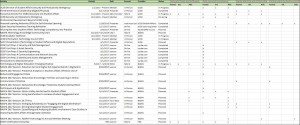The technology competency in the latest ACPA/NASPA Professional Competencies(2015) and the corresponding rubric provide student affairs practitioners and administrators guidance on effectively learning and applying technology in their roles as educators and programmers for student success. In addition, the two documents are also useful to the same groups regarding self-directed and formal professional development.
In my role as student affairs IT director, educator, and student affairs administrator, I was very interested in technology competency when it became available and how it could be applied to my organization and for my personal learning. I’ve offered my thoughts in this blog post.
I found the competency and the rubric to be useful for the following reasons:
1) I’m able to identify areas I need to pursue. For example, most of my experiential learning and training has been mostly on “technical tools and software” and “data use and compliance” so when I planned my schedule for the NASPA national conference in San Antonio next week (March 10-15), I purposely planned my schedule to attend sessions on “digital identity and citizenship” and “online learning environments”.
2) As I defined areas I need further development, I began exploring other learning methods. For example, most of my education when it comes to technology over the last three years has been through my job and also through kindle books. This year, I discovered Lynda.com videos and have completed seven data governance and security courses.
3) The techniques and mindset I have developed through the technology competency have also led me to apply them in other development areas beyond technology. I recently completed a 10-course series on people management certification via the University of California online learning system.
4) Given the lessons learned from my experience in applying the competency and rubric, I am developing a training curriculum for our division of student affairs based on the competency and rubric with the support of our Vice Chancellor for Student Affairs. I hope that by next year’s NASPA conference, we will have implemented the curriculum and presented our experience so other student affairs practitioners and administrators may consider using the competency for their institutions.
Dr. Josie Ahlquist, and I presented via webinar (Infusing The New Student Affairs Technology Competency Into Practice) last month on how the competency could be applied in graduate programs, student affairs organizations, and professional development. Part of the presentation focused on using the competency framework for professional development. I offered how I have used and plan to use the competency and the rubric to guide my learning. Using Excel, I created a template that lists learning activities, when I would pursue them, the format, and which areas of the technology competency rubrics these activities fulfill. The template also provides a link to the rubric.
Attached is the Excel file I developed, and please feel free to modify them for your use. Click on the image to download the file.
I look forward to how other institutions and student affairs professionals apply the competency and rubric. If you or your institution have used these tools, I would love to learn more about them.
